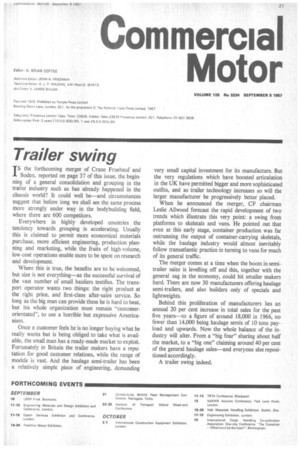Trailer swing
Page 23

If you've noticed an error in this article please click here to report it so we can fix it.
TS the forthcoming merger of Crane Fruehauf and Boden, reported on page 37 of this issue, the beginning of a general consolidation and grouping in the trailer industry such as has already happened in the chassis world? It could well be—and circumstances suggest that before long we shall see the same process more strongly under way in the bodybuilding field, where there are 600 competitors.
Everywhere in highly developed countries the tendency towards grouping is accelerating. Usually this is claimed to permit more economical materials purchase, more efficient engineering, production planning and marketing, while the fruits of high-volume, low-cost operations enable more to be spent on research and development.
Where this is true, the benefits are to be welcomed, but size is not everything—as the successful survival of the vast number of small hauliers testifies. The transport operator wants two things: the right product at the right price, and first-class after-sales service. So long as the big man can provide these he is hard to beat, but his whole organization must remain "customerorientated", to use a horrible but expressive Americanism.
Once a customer feels he is no longer buying what he really wants but is being obliged to take what is available, the small man has a ready-made market to exploit. Fortunately in Britain the trailer makers have a reputation for good customer relations, while the range of models is vast. And the haulage semi-trailer has been a relatively simple piece of engineering, demanding very small capital investment for its manufacture. But the very regulations which have boosted articulation in the UK have permitted bigger and more sophisticated outfits, and as trailer technology increases so will the larger manufacturer be progressively better placed.
When he announced the merger, CF chairman Leslie Allwood forecast the rapid development of two trends which illustrate this very point: a swing from platforms to skeletals and vans. He pointed out that even at this early stage, container production was far outrunning the output of container-carrying skeletals, while the haulage industry would almost inevitably follow transatlantic practice in turning to vans for much of its general traffic.
The merger comes at a time when the boom in semitrailer sales is levelling off and this, together with the general sag in the economy, could hit smaller makers hard. There are now 30 manufacturers offering haulage semi-trailers, and also builders only of specials and lightweights.
Behind this proliferation of manufacturers lies an annual 20 per cent increase in total sales for the past five years—to a figure of around 18,000 in 1966, no fewer than 14,000 being haulage semis of 10 tons payload and upwards. Now the whole balance of the industry will alter. From a "big four" sharing about half the market, to a "big one" claiming around 40 per cent of the general haulage sales—and everyone else repositioned accordingly.
A trailer swing indeed.




















































































































